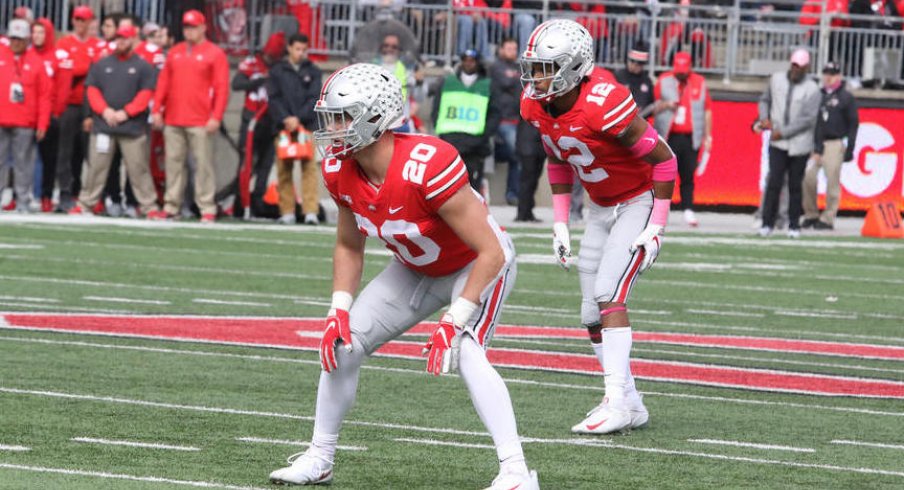“They had a good game plan, and they used it pretty well.” - Linebacker Pete Werner following Ohio State's 30-14 victory over Minnesota.
Very often, what a powerhouse program like Ohio State sees on a future opponent's game tape ends up being far different than what shows up on game day.
“We’re going to see teams’ best, and we’re going to see maybe a little bit of different flavor some weeks,” co-coordinator Alex Grinch said last Saturday. “A week ago, our opponent (Indiana) I think went empty (formation with no running backs) seven times the entire season (before playing Ohio State) and then in our game alone, they ran it 18 times. And so there’s a little bit of that adjustment.”
Such was the case in the Buckeyes less-than-dominant win over the Gophers, as though the home team held their opponent scoreless in the second half, few fans left the Horseshoe feeling great about the performance of their defense. While many theories emerged in real-time, it appears in hindsight as though the opposing offense simply came into the contest with a strong game plan that OSU wasn't expecting, and they were able to execute in the first half.
Though it was quite effective, the plan set forth by P.J. Fleck and his staff was also quite simple, attacking the alley by placing Ohio State's outside linebackers in conflict with the use of run/pass options (RPOs) that often left the slot receiver in a one-on-one battle with embattled field safety Isaiah Pryor.
On the very first play of the game, Minnesota QB Zack Annexstad pulled the ball back as he watched Werner crash down quickly to stop a split-zone run, standing tall in the pocket and hitting wide open receiver Tyler Johnson on a speed-out route.
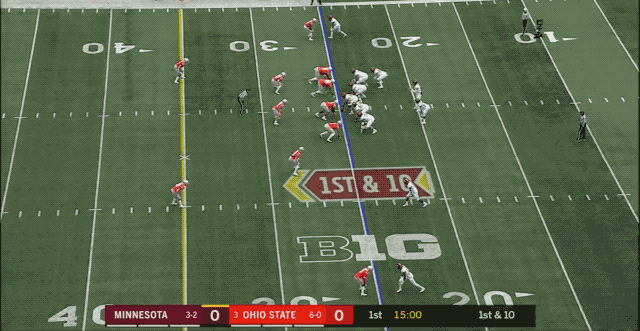
But anyone that assumes this was the same, old problem we've seen from time to time with the pass defense this season is sorely mistaken. After much commotion and hand-wringing following a 322-yard performance from the Indiana passing game the week before, Greg Schiano's secondary changed their shape against the Gophers.
Instead of relying heavily on the press-man, bump-&-run coverage with which Buckeye cornerbacks have been so successful under Schiano's guidance, Kendall Sheffield, Damon Arnette, and Jeffrey Okudah instead played a press-bail technique outside against the Minnesota receivers.
Watch former Stanford cornerback Alex Carter explain the difference between the two:
While the former, press-man technique is most effective at disrupting the receiver at the line of scrimmage and throwing off short timing patterns, it leaves the defender vulnerable to deep passes over the top. Additionally, the defender's back is often turned to the ball, making it nearly impossible to make stops in the run game.
In a bail technique, the cornerback can stay on top of any deep routes and keep an eye on the backfield at the same time. It's also the same technique used to play a Cover-3 zone, which allowed Schiano to mix and match between man and zone coverages without giving the quarterback many clues. Watch below as Sheffield perfectly executes the bail technique, resulting in an early interception:
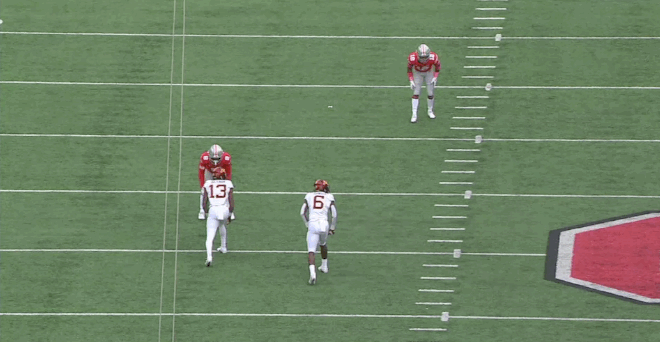
But such a technique can't be played by slot defenders like Pryor. Beginning at a depth of ten yards, Pryor instead was forced to play a catch-man technique when a zone defense wasn't called, keeping his shoulders square to the line and mirroring the movements of the receiver.

Yet Pryor struggled to read the movements of the receiver and was often caught flat-footed by the receiver as he made his break inside before the safety could disrupt the route.
“They had an RPO concept that brought me in as a linebacker and then used the one-on-one slant concept and kind of dialed back there," Werner said. "It’s a hard route to defend from my standpoint. I got to try to get my hand on the ball for that. But yeah, that’s a tough one to defend, especially with our defense.”
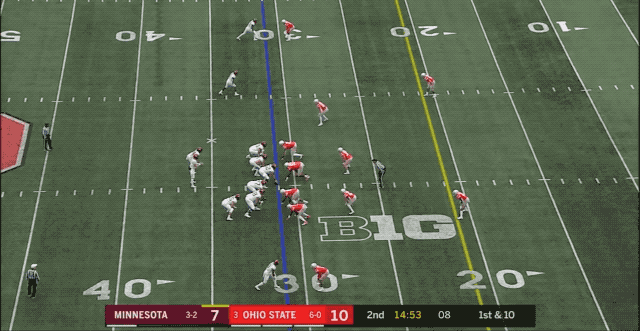
In an effort to counter such action, Schiano began calling for his outside linebacker to the twins side to drop into a pattern-matching coverage, playing a three-over-two shell and walling off any inside patterns. But despite his efforts, backup linebacker Justin Hilliard struggled in his role while filling in for the injured Malik Harrison.
With the safety playing over the top to prevent any deep routes, the receiver simply broke past the 10-yard depth Hilliard was expected to cover, turning his slant into a deep cross and finding open space over the middle. Luckily, Hilliard was able to recover after one of these completions to cause a fumble, but such instances were rare.
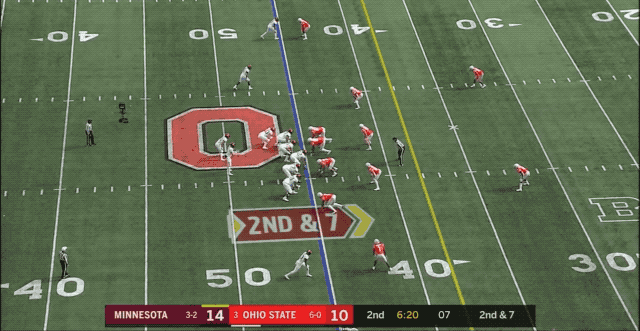
Dropping a linebacker into dedicated coverage also often left the Buckeyes a man short in run-coverage, though, and Schiano often compensated by blitzing the boundary corner to seal the edge (as seen in the example above). But Fleck and his staff did an excellent job of anticipating Schiano's calls, using formations like a trips set into the boundary to overload the defense to one side.
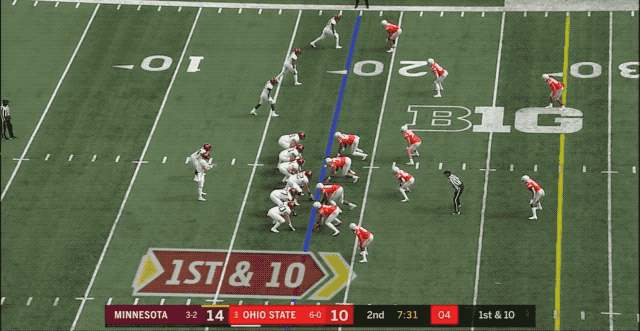
While Hilliard (#47) is in position to close the backside A-gap in the example above, his lack of meaningful playing time showed. Instead of absorbing contact with his inside shoulder and keeping his outside arm free to make a play on the runner, he takes on the blocker with both hands, turning his shoulders away from the gap. This movement creates a seam for the back while safety Jordan Fuller is rotated over to help defend the three receivers side and unable make a play.
Mistakes like these from inexperienced defenders plagued the Buckeye front-seven all afternoon. On an early third down, defensive end Tyreke Smith (#11) came into the game to act as an additional pass rusher from an interior alignment. At the snap, the Buckeyes appeared to have every run gap filled, but all 300 lbs of Gophers' senior center, Jared Weyler, blew the 255 lb freshman five yards off the ball, creating a wide open hole for running back Mohamed Ibrahim.

At halftime, however, Schiano and his staff were able to adjust. Instead of letting Minnesota dictate the Buckeyes' alignment based on the placement of the tight end, Schiano borrowed a page from his co-coordinator's old Washington State playbook.
While running the Cougar defense, Grinch was famous for stemming his defensive line - essentially the defensive version of sending a receiver in motion before the snap. While they'd show one formation as both teams came to the line, the OSU front four would shift down a gap just before the snap, leaving the massive Minnesota blockers to determine their assignments on the fly against the quicker defenders.
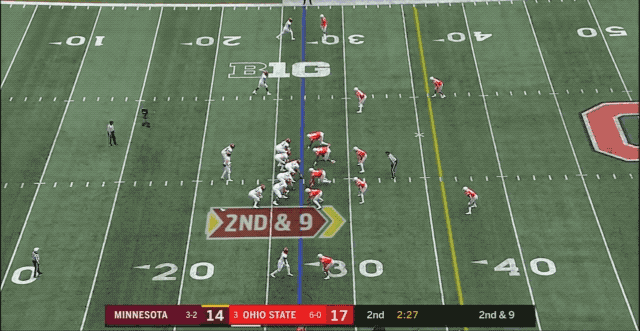
A critical personnel change also seemed to make a big difference as the game wore on. Though he has only played the position for a matter of weeks, converted cornerback Shaun Wade was inserted at the field safety spot for Pryor, using his more natural coverage skills to take away the slants that had stolen yards all day.
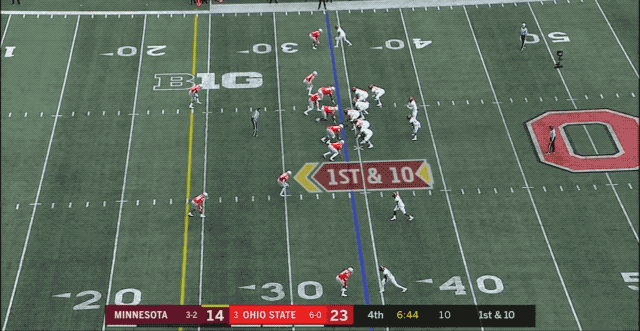
Additionally, Werner and Hilliard began anticipating the slant routes and made an effort to disrupt the throwing lanes whenever possible, as Hilliard did on a critical third down late in the third quarter.
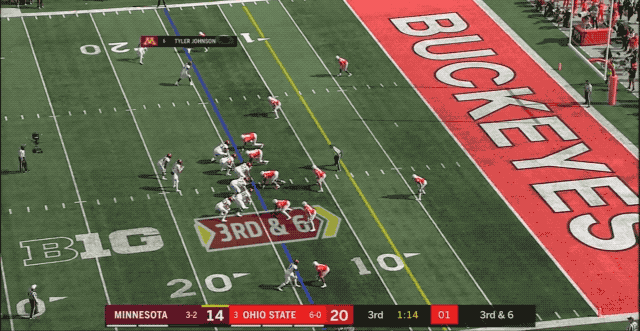
“We prepare all week for teams, and sometimes they don’t give us what exactly we prepare for,” Hilliard said. “But as far as defense, we got to be able to just go down to our base rules and be able to do anything, play anything.”
While many fans are clearly frustrated with the unit's inability to stop a seemingly lesser opponent, they should find comfort in the coaching staff's ability to make the corrections necessary to handle personnel or concepts they hadn't anticipated. As has been the case all season, the Buckeyes clamped down in the second half and limited the Gophers to only 158 total yards and, most importantly, zero points.
| Half | Comp % | Yards | TD | INT | QB Rtg | 1st Downs |
|---|---|---|---|---|---|---|
| 1st | 56.9% | 975 | 5 | 2 | 133.66 | 42 |
| 2nd | 48.4% | 576 | 3 | 4 | 103.61 | 23 |
“The strength is that they came out and shut them out in the second half, a lot like the game last week where we held a team to 92 yards in the second half,” Meyer said. “And the best thing is we created some turnovers, and that was the difference in the game.”
Add in the fact that three starters were absent (Harrison, Nick Bosa, and Jonathan Cooper), and three others are battling nagging injuries (Dre'Mont Jones, Robert Landers, and Damon Arnette), and it becomes a little easier to see why the unit has struggled recently. The healthy return of those players should go a long way toward correcting the issues Buckeye fans have grown tired of seeing.
But that doesn't mean Schiano, Grinch, and co. won't continue to try and improve in their absence.
“We’re running out of time in terms of being young,” Grinch said. “Is it a work in progress? I think it always is, but it’s time now for us to get our feet underneath us and perform better.”
